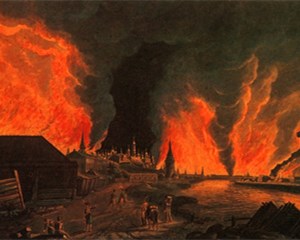Mortier, as governor of the city, immediately issued his orders, and was putting forth every exertion, when at daylight Napoleon hastened to him. Affecting to disbelieve the reports that the inhabitants were firing their own city, he put more rigid commands on Mortier to keep the soldiers from the work of destruction. The marshal simply pointed to some iron-covered houses that had not yet been opened, from every crevice of which smoke was issuing like steam from the sides of a pent-up volcano. Sad and thoughtful, Napoleon turned towards the Kremlin, the ancient palace of the Czars, whose huge structure rose high above the surrounding edifices.

In the morning, Mortier, by great exertions, was enabled to subdue the fire. But the next night, Sept. 15, at midnight, the sentinels on watch upon the lofty Kremlin saw below them the flames bursting through the houses and palaces, and the cry "Fire! fire!" again passed through the city. The dread scene was now fairly opened. Fiery balloons were seen dropping from the air and alighting on the houses; dull explosions were heard on every side from the shut-up dwellings: the next moment light burst forth from them, and the flames were raging through the apartments.












